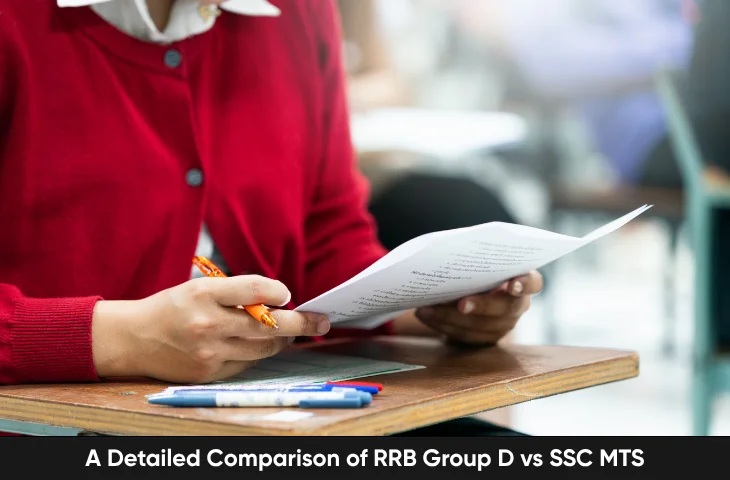Choosing your first government job is a big decision, especially when two popular entry-level routes, RRB Group D and SSC MTS, seem to offer similar benefits: security, a steady salary, and predictable work-hours. This article breaks down RRB Group D vs SSC MTS across eligibility, exam pattern, syllabus, difficulty, career growth, pay & perks, preparation strategy, and suitability for beginners, so you can pick the path that fits your circumstances and goals.
RRB Group D vs SSC MTS Which is Easy?
Candidates must choose according to their preference between RRB Group D and SSC MTS. The table below shows the detailed comparison:
| Parameters | RRB Group D | SSC MTS |
| Typical employer | Indian Railways (regional RRB) | Various Central Government Ministries/Departments |
| Eligibility (typical) | 10th pass (minimum), age limits vary | 10th pass (secondary), age limits vary |
| Exam pattern | Computer-based test (CBT) + Physical or medical for some posts | Computer-based test (CBT) or Computer-based objective + skill/physical only for few posts |
| Syllabus focus | General Science (basic), Maths (basic), Reasoning, GK | General Intelligence, Numerical Ability, General Awareness, Grammar/Language |
| Difficulty (for beginners) | Moderate (some trade/fitness elements for certain posts) | Moderate–easy (reasoning & basic maths important) |
| Preparation time (typical) | 2–4 months (focused) | 1.5–3 months (consistent) |
| Promotions & growth | Multiple departments, structured railway promotion avenues | Department-dependent; promotions possible but less uniform |
| Work location | Often transfers and postings across railway zones; may be remote | Desk jobs in urban/regional offices; postings vary by department |
| Perks & allowances | Railway allowances, travel concessions | Central Govt allowances (HRA, TA) — varies by posting |
| Suitability for beginners | Good for hands-on, stable work and allowances | Good for those preferring desk/office roles and urban posting |
RRB Group D vs SSC MTS Which is Better?
Choosing between RRB Group D vs SSC MTS requires considering various factors. However, the main exam overview between the two is given below:
RRB Group D
RRB Group D recruits for a wide range of grassroots railway posts such as track-maintenance, helper, gateman, porter, and other level-1 categories. The role often includes physical work, shift patterns, and in many cases eligibility for railway-specific allowances and travel perks.
SSC MTS
SSC MTS (Multi Tasking Staff) recruits for support-level posts in various central government ministries and departments. Typical duties are clerical support, office errands, or non-technical assistant work. Work is usually office-based, and postings are spread across department offices.
Eligibility and Selection Process of RRB Group D vs SSC MTS
Candidates must meet the eligibility and selection process for both RRB NTPC vs SSC MTS posts. Check out the details given below:
- Educational: Both exams commonly require at least a 10th standard pass. Age limits and relaxation categories follow government norms.
- Selection: Both rely heavily on a CBT (objective test). RRB Group D may include physical efficiency/medical tests for certain posts; SSC MTS may have a descriptive language paper or skill test for some categories historically.
Syllabus and Exam Difficulty of RRB Group D vs SSC MTS
Applicants must cover all the topics from RRB Group D Syllabus. Given below are the details:
- Mathematics: Basic arithmetic — percentages, ratios, averages, time & work, simple algebra.
- General Science: Basic school-level science (physics, chemistry, biology) — often factual or conceptual.
- General Intelligence & Reasoning: Series, coding-decoding, analogy, puzzles.
- General Awareness / Current Affairs: Basic national affairs, Indian polity basics, geography.
SSC MTS Syllabus:
- General Intelligence & Reasoning: Analogies, classification, pattern recognition.
- Numerical Ability: Arithmetic and simplification.
- General Awareness: Static GK + current affairs.
- English Language/Comprehension: Basic grammar and comprehension (varies by year).
Verdict on difficulty: Both exams are beginner-friendly if you practice regularly. SSC MTS often tests more of language and reasoning; RRB Group D includes a practical/fitness dimension for some posts, which can raise the overall ‘selection difficulty’ slightly for those who are not physically prepared.
Career Growth and Stability of RRB Group D vs SSC MTS
The career growth options in both RRB Group D and SSC MTS are numerous. Check out the following information:
- RRB Group D: The railways are large and structured. There are departmental exams, seniority-based promotions, and many internal streams (technical, trades, clerical) in which an employee can transition. Railway jobs often come with travel concessions and other strong perks.
- SSC MTS: Career growth depends heavily on the hiring department. While upward mobility exists (through departmental exams and SSC exams), it is typically less structured than railway-specific ladders. Many candidates use SSC MTS as a stepping stone to other SSC exams or departmental opportunities.
Work Life and Culture:
- RRB Group D: May involve shift work, outdoor or field duties, and postings that are sometimes in non-urban locations. Good fit if you’re comfortable with physical work and open to transfers.
- SSC MTS: More likely to be posted to offices and urban centers; generally stable day-shift hours. Suits those preferring office work and city living.
RRB Group D vs SSC MTS Salary
The RRB Group D Salary is ₹18,000 per month. On the other hand the SSC MTS salary after allowances and deductions sums up to nearly ₹24,000 – ₹30,000.
| Component | RRB Group D | SSC MTS |
| Pay Level (as per 7th CPC) | Level 1 (Grade Pay ₹1800) | Level 1 (Grade Pay ₹1800) |
| Basic Pay | ₹18,000 per month | ₹18,000 per month |
| Dearness Allowance (DA) | ~46% of Basic Pay (≈ ₹8,280) | ~46% of Basic Pay (≈ ₹8,280) |
| House Rent Allowance (HRA) | 8%–24% (depends on city class) • X (Metro): ₹4,320 • Y: ₹2,880 • Z: ₹1,440 | 8%–24% (depends on city class) • X (Metro): ₹4,320 • Y: ₹2,880 • Z: ₹1,440 |
| Transport Allowance (TA) | ₹900 – ₹3,600 (depending on city and department) | ₹900 – ₹3,600 (depending on posting) |
| Other Allowances | Railway Duty Allowance, Night Duty, Running Allowance (for some posts), Overtime | Dress Allowance, Festival Advance, Department-specific allowances |
| Gross Monthly Salary (Approx.) | ₹28,000 – ₹35,000 (depending on city & allowances) | ₹27,000 – ₹33,000 (depending on posting & allowances) |
| In-hand Salary (after deductions) | ₹25,000 – ₹31,000 | ₹24,000 – ₹30,000 |
| Annual Salary (Approx.) | ₹3.0 – ₹4.0 lakh per annum | ₹2.9 – ₹3.8 lakh per annum |
| Promotion Opportunities | Can rise to Technician, Junior Engineer, Station Master (via departmental exams) | Can rise to Clerk, Assistant, and higher administrative posts (via departmental exams) |
| Additional Perks | Free/subsidized railway travel, medical facilities for family, pension (NPS), staff quarters | CGHS medical benefits, LTC (Leave Travel Concession), pension (NPS), government holidays |
RRB Group D vs SSC MTS – Ideal Preference
A candidate must apply for the particular exam after reviewing each aspect. Given below are certain conditions:
Pick RRB Group D if:
- You prefer a job with railway-specific perks (travel, allowances).
- You don’t mind physical work or field postings.
- You’re aiming for a long-term railway career with internal promotion prospects.
Pick SSC MTS if:
- You prefer office-based work and urban postings.
- Your strengths are language, general awareness, and reasoning.
- You want a broader government-experience base across ministries and departments.
Key points of RRB Group D vs SSC MTS
The key points of the article are discussed below for a quick look:
- Similarity: Both require only 10th pass and a short to moderate preparation window — ideal for first-time government job seekers.
- Difference: RRB Group D often includes physical/field duties and railway perks; SSC MTS tends toward office work in central departments.
- Difficulty & Prep: Comparable; success depends on consistent practice, mocks, and topic revision.
- Career: RRB may offer more structured rail-specific promotion pathways; SSC MTS offers broader exposure across central departments.
- Best fit: Choose based on lifestyle preference (field vs office), willingness for transfers, and long-term career goals.
When weighing RRB Group D vs SSC MTS, there is no objectively “better” choice for every beginner, only one that matches your strengths and life goals. If you value railway perks and accept physical or variable postings, RRB Group D can be more rewarding in the long run. If you prefer office hours, urban postings, and language/reasoning-oriented work, SSC MTS is likely a better fit.
FAQs
Both exams are considered beginner-friendly. However, SSC MTS generally focuses more on reasoning, English, and general awareness, while RRB Group D includes General Science and a physical test for some posts. If you are more comfortable with factual and numerical topics, RRB Group D may feel easier; if you prefer reasoning and language-based questions, SSC MTS might suit you better.
RRB Group D has a more structured promotion ladder within the railway system. With departmental exams and experience, employees can be promoted to Technician, Junior Engineer, or Station Master posts. In SSC MTS, promotions depend on the department you’re posted in, and growth is slower unless you qualify for higher-level SSC exams like CHSL or CGL.
Both posts have similar pay scales under Level 1 of the 7th CPC (Basic Pay ₹18,000).
However, RRB Group D employees usually enjoy more additional perks such as free/subsidized railway travel, overtime allowances, and special duty pay, making their total benefits slightly higher than SSC MTS employees.
RRB Group D: Includes field and maintenance-related tasks such as track upkeep, assisting mechanics, handling goods, or operational duties in railway stations and workshops.
SSC MTS: Involves office-based tasks like file handling, document delivery, photocopying, dispatching mail, and assisting clerical staff in central government offices.
It depends on your career goals and lifestyle preferences:
Choose RRB Group D if you want long-term railway benefits, structured promotion opportunities, and don’t mind physical or shift work.
Choose SSC MTS if you prefer a stable office environment, urban postings, and opportunities to move to higher SSC posts later.

Hello! This is Arijit Dutta. I am a skilled Content Writer at Oliveboard with nearly 3+ years of experience in crafting engaging, informative, and exam-focused content for the Railways Domain. With a strong command of language and a keen understanding of learner needs, I contribute significantly to Oliveboard’s mission of delivering high-quality educational resources. Passionate about clear communication and continuous learning, I consistently create content that helps government job aspirants achieve their goals. Outside of work, I enjoy playing cricket and listening to music, which helps me stay balanced and creative in my professional journey.
